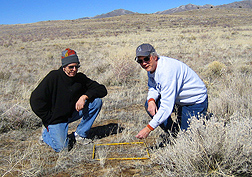This page has been archived and is being provided for reference purposes only. The page is no longer being updated, and therefore, links on the page may be invalid.
|
Read the magazine story to find out more. |
|
|
|
|
Cheatgrass' Success Secret Revealed
By Marcia WoodJuly 29, 2009
Cheatgrass, a weedy invader that looks something like a scraggly wheat plant, is elbowing its way into vast rangelands of the American West. Known to scientists as Bromus tectorum, this fast-growing intruder crowds out native plants that cattle or wildlife could otherwise eat. And, because it burns hot and fast, cheatgrass boosts the wildfire hazard.
Agricultural Research Service (ARS) ecologist William Longland and ARS geneticist Michael Ashley, at the Exotic and Invasive Weeds Research Unit in Reno, Nev., are investigating cheatgrass in ongoing studies aimed at finding affordable, environmentally friendly ways to thwart its spread.
In determining how the plant fertilizes, or pollinates, its tiny flowers--so that they will form seeds and produce a new generation of plants--the scientists uncovered one secret to cheatgrass' success. Contrary to the generally held opinion that cheatgrass is exclusively self-pollinating--that is, each plant reproduces by itself--the scientists have shown that cheatgrass plants can pollinate or fertilize each other.
This cross-pollination is an unarguable plus for cheatgrass, according to the researchers. Here's why: The exchange of pollen among individual cheatgrass plants can yield offspring with a genetic base that's broader, or more diverse, than that of either of the parents. A broader genetic base may give the new generations a greater ability to adapt to a wider range of environments and stresses than plants that only self-pollinate. For an invader such as cheatgrass, native to Europe and Asia, greater adaptability is an important asset.
In their experiments, Longland and Ashley examined segments of genetic material, known as microsatellite markers, and used them to determine whether cheatgrass plants that they sampled were self- or cross-pollinated. The researchers documented their findings earlier this year in the Western North American Naturalist, and in a 2007 issue of Plant Species Biology.
Read more about this research in the July 2009 issue of Agricultural Research magazine.
The cheatgrass studies are part of the ARS Areawide Pest Management Program for Annual Grasses in the Great Basin Ecosystem, aimed at undermining troublesome annual plants like cheatgrass.
ARS is the U.S. Department of Agriculture's principal intramural scientific research agency.

